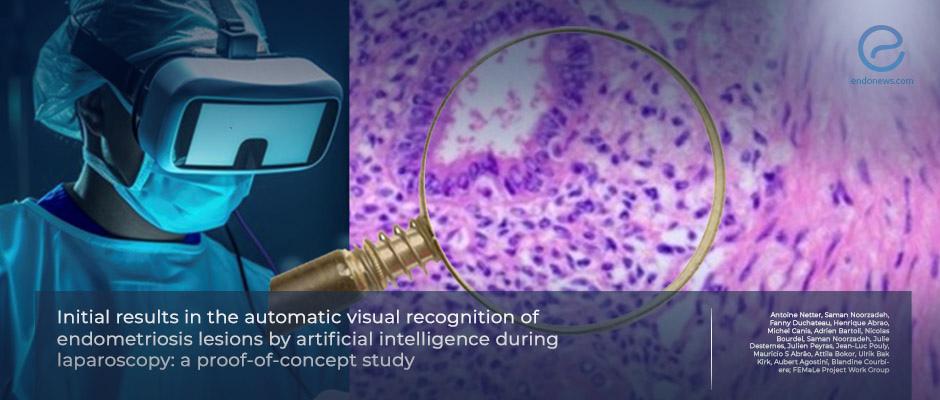AI-Assisted Vision: Recognizing Endometriosis in Real Time
Oct 17, 2025
Proof-of-concept study brings artificial intelligence into the surgical diagnosis of endometriosis.
Key Points
Higlight:
- Artificial intelligence (AI) shows promising capability in visually recognizing endometriosis lesions during laparoscopic surgery.
- This proof-of-concept study demonstrates the feasibility of deep-learning algorithms to assist surgeons in intraoperative lesion detection.
- The technology aims to reduce diagnostic variability and improve surgical precision.
Importnce:
- Endometriosis diagnosis currently depends on the surgeon’s visual recognition during laparoscopy, which is inherently subjective.
- AI-assisted visual models could standardize detection, shorten diagnostic delay, and enhance surgical completeness, especially in centers with variable expertise.
What's Done Here?
- Researchers developed and validated a deep-learning convolutional neural network (CNN) trained on laparoscopic videos and still images from multiple institutions.
- Data included annotated images of peritoneal, ovarian, and deep infiltrating endometriosis.
- The model’s diagnostic performance was tested against expert human reviewers for accuracy, sensitivity, and specificity.
Key Results:
- The AI model successfully distinguished endometriosis lesions from normal peritoneum with high sensitivity and acceptable specificity.
- Detection performance approached that of experienced surgeons in identifying subtle or atypical lesions.
- The algorithm maintained robust accuracy across video frames and lighting conditions, demonstrating potential for real-time intraoperative application.
- These results validate the technical feasibility of AI-assisted surgical decision support in endometriosis.
Strengths and Limitations:
- The ulticenter image dataset and use of expert-verified annotations strengthen external validity; introduces an emerging tool for standardizing visual diagnosis are strengths of the study.
- Limitations are, proof-of-concept design with a relatively limited dataset; further multicenter validation and real-time integration studies are required before clinical adoption.
From the Editor-in-Chief – EndoNews
"This proof-of-concept study represents a landmark step in surgical innovation, introducing artificial intelligence into the visual diagnosis of endometriosis. The ability of deep-learning algorithms to recognize disease patterns intraoperatively could ultimately help standardize detection, reduce operator dependence, and shorten the time to diagnosis—longstanding challenges in this field.
However, enthusiasm for technological progress must be matched by scientific rigor. The present study is based entirely on surgeon-annotated images without histopathologic confirmation, meaning the algorithm currently recognizes visual patterns suggestive of endometriosis, not the disease itself. As visual appearance alone is not always reliable, future models must incorporate pathology-verified data to ensure diagnostic validity and clinical safety.
The promise of AI lies not in replacing the surgeon or the pathologist but in enhancing their precision, harmonizing decision-making, and expanding diagnostic equity. When pathology integration and multicenter validation are achieved, artificial intelligence will no longer just assist recognition—it will help redefine objectivity in surgical diagnosis."
Lay Summary
Artificial intelligence (AI) may soon assist surgeons in recognizing endometriosis during minimally invasive surgery. In a proof-of-concept study published in the Journal of Minimally Invasive Gynecology, Netter and collegues evaluated a deep-learning algorithm designed to visually detect endometriosis lesions on laparoscopic images and videos.
The team trained the AI model using surgical footage collected from multiple medical centers, encompassing various presentations of peritoneal, ovarian, and deep infiltrating endometriosis. When tested, the model was able to identify lesions with accuracy comparable to experienced surgeons, even under variable lighting and image conditions.
This approach represents an important step toward objective, standardized intraoperative diagnosis. Visual assessment of endometriosis is currently subjective and highly dependent on surgical experience; AI could help reduce these inconsistencies, guide less experienced surgeons, and ensure more complete treatment of visible disease.
While the technology remains in early development, its potential implications are profound. By integrating machine learning into the operating room, future endometriosis surgeries may become more accurate, reproducible, and equitable across healthcare systems, helping bridge the gap between expert and novice surgical outcomes.
Research Source: https://pubmed.ncbi.nlm.nih.gov/40912397/
artificial intelligence minimally invasive innovation visualization diagnosis pathology

